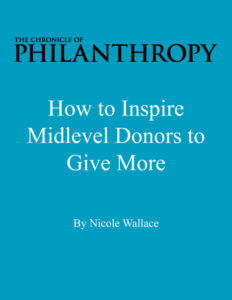“Midlevel contributors are usually a relatively small portion of a nonprofit’s donors, but they give an outsize amount of money and tend to be more loyal than small-dollar donors.”
Mark Rovner, Principal at Sea Change Strategies
 What is this article?
What is this article?
This article offers valuable insight into the importance of targeting midlevel donors so as not to leave money on the table. At many institutions, midlevel donors have fallen through the cracks because they were thought to be worth too much for a direct mail campaign but not enough for a major gift focus. They warrant more attention. The author gives examples from veteran fundraisers of how to engage midlevel donors and the return on the efforts.
What are key findings from the article?
Focusing on midlevel donors will pay dividends if executed properly.
- Rovner states that multiyear retention rates of “70 to 75 percent are not unusual.” The author cites Best Friends Animal Society as an organization that is reaping the rewards of inspiring midlevel donors. Constituents who give $1,000 to $25,000 annually to the organization account for 2% of donors; however, they also account for 30% of gifts to the annual fund.
- Good customer service is the first step in attracting these donors. If they don’t feel well cared, they might not wish to contribute further.
- Future data collection planning is key when setting up a midlevel-giving program since it is difficult to go back and re-define processes when a program grows in size. Doing so while the program is small and manageable will ease the burden. Think about data points such as interests and behavior. What might you need to collect in order to connect with these donors?
- Effective segmentation of the database is important for targeting donors who might warrant more specialized attention.
- Talking with midlevel donors via phone or email gives a more accurate picture of what donors want, one of which is to understand how their giving has impacted the organization. It feels good to be in the know, especially when you’re being told that you’re making a difference.
- It’s important to build a sense of community and to let donors experience the mission. This relates to letting the donors feel good about the contributions they make.
What can I do as a result?
- Identify: Look for affinity first, even if you only have past giving behavior. Try pulling a list of individual donors who have given recently, frequently, over a long period of time, and who fall within your mid-range of annual giving amount. If you don’t know what your mid-range of giving is you can run a quick mean, median, and mode calculation on total cumulative giving per donor in your last fiscal year to begin figuring it out.
- Cultivation: Is there a simple way you help your donors “experience the mission?” Host (and video-tape) a one-hour talk by the CEO or a subject matter expert during which the problem the organization is trying to solve and the organization’s successes are discussed. Deepen engagement with your volunteers and donors by asking them to host this “punch-and-cookies” event.
- Stewardship: Are you sending handwritten gift thank you notes? Deepen engagement with your board members and volunteers by asking them to write thank you notes to your mid-level donors. You might even consider giving them a script and asking them to make thank you calls, especially for higher gift amounts.
- Staffing: Mid-level donors are perfect training grounds for future major gift officers. Are you hiring your first major gift officer? Start with calls and visits to mid-level donors. Or you can hire a dedicated mid-level donor officer and create a career path.
- For specifics on how to plan for a midlevel donor program, see Advancing Philanthropy’s “A Strong Middle Promotes a Healthy Fundraising Program” (link below). The article offers insights on how to define what constitutes midlevel for your particular institution, how to do data analysis and use data appends, and how to take action.
Additional Resources
- How to Inspire Midlevel Donors to Give More | Nicole Wallace via The Chronicle of Philanthropy | 2018
- The Mid-Level Donor Crisis Your Organization May Be Suffering From | Brady Josephson via Huffington Post | 2017
- Cultivating Mid-Level Donors: 5 Things to Think About | Kurt Worrel via The Giving Institute | 2016
- A Strong Middle Promotes a Healthy Fundraising Program | Laurence C. Henze, JD via Advancing Philanthropy | 2012
